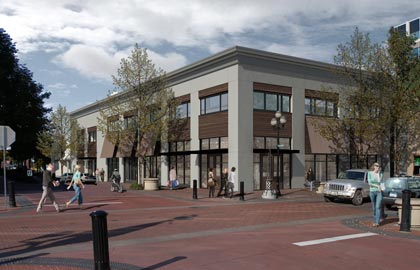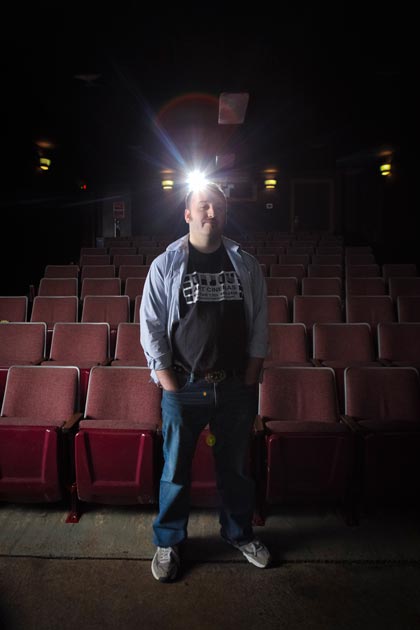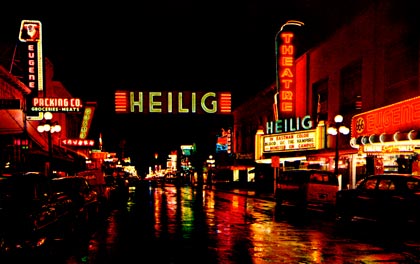Downtown Eugene: On a spring evening in 1938, Shirley Temple, Laurel and Hardy, Mae West, Ginger Rogers and the Three Stooges could be seen posing for the paparazzi under the bright lights of the Heilig Theater marquee where the Hult Center now stands. OK, they were actually local actors hired by the theater for the “Hollywood Premiere and Follies,” a show replicating the Hollywood glamour of an opening night at the Grauman’s Chinese Theater and slated by The Register-Guard as “one of the biggest social and theatrical events ever seen in this city.”
Over 70 years later, decades after the last downtown Eugene movie house closed, Bijou Art Cinemas is opening a second location at Willamette and Broadway with the hope of helping revitalize the city’s core through cinema and culture again. But in today’s ever-changing media landscape, it may be harder than ever to lure would-be moviegoers away from their HD flat-screen-equipped living rooms, where movies can be found for little to no cost via iTunes, Netflix or BitTorrent, and into the theater. “It’s pretty crucial that movie theaters actually offer some sort of experience,” says Ed Schiessl, who co-owns and operates Bijou Art Cinemas with Louise Thomas and Jamie Hosler. “We can’t just offer a seat to sit in for five bucks anymore.”
 |
| Digital rendering of the plans for the new Bijou Metro. digital rendering courtesy Master Capital Management |
 |
| Ed Schiessl |
Opening in spring 2013, the new Bijou Metro will serve local beer, wine and a limited gourmet menu. The First National Tap House, an English-style pub, will open next door and connect directly to the theater. Outfitted with four auditoriums — two 40-seaters and two 20-seaters — the Metro will curate film series (think kung fu, old classics, ’80s action flicks), expand and tailor programming for Eugene audiences (seven-days-a-week matinees, a screen devoted to classics) and grow partnerships with the community through events like DisOrient and the UO’s Film on Film series. For now, ticket prices will remain the same as the original Bijou.
Build it and they will come
When “talkies” first hit the silver screen in the late ’20s, Eugene had five theaters (the Heilig, the Rex, the Colonial, the Eugene State Theater and the McDonald), and by 1980, more than 10 theaters lit up the town with their marquees. Today, the city is host to three theaters: the Regal Valley River Center Stadium 15, the David Minor Theater and the Bijou. Forty years after what was then called the Eugene Renewal Agency razed the Heilig — Eugene’s oldest movie theater — the Bijou Metro will open with the aid of the current Eugene Urban Renewal Agency. Unlike the controversial 12-screen multiplex that was originally proposed by the urban renewal project in the mid-aughts, the Bijou Metro will be a compact venue totaling 3,300 square feet.
Crafting an experience was on Schiessl’s mind two years ago when he started working with developer Steve Master of Master Capital Management LLC and Denny Braud and Mike Sullivan of Eugene’s Urban Renewal Agency. According to Braud, the city of Eugene is financing $70,000 for the Bijou Metro and $500,000 for Master Capital Management LLC to revamp the Bijou site, the former First National Bank building and later a Taco Time, through the Downtown Revitalization Loan Program (other loan benefactors coming to the block include Off The Waffle, Noisette Pastry Kitchen and The Barn Light). Braud, who describes the Bijou Metro as “the perfect project for downtown,” estimates that the city has invested about $20 million into the Broadway area thus far.
“If X marks the spot,” Master says, pointing to the intersection of Willamette Street and Broadway Avenue, “this is the best corner in Eugene. It just doesn’t get better than this.”
Standing on the first floor of the gutted 19th-century bank building, Master’s voice is barely audible over the cacophony of drills and hammers working overhead on 16 luxury apartments, also owned by Master. “This is going to be the First National Tap House,” he says, patting a cobbled brick wall. Master and business partner developer Tim Weiskind (their other projects include the Park Place apartments downtown) are looking to collaborate with the Metro. “We’re going to do a projector on the wall and Ed is going to supply us with old movies to play.”
There will also be a digital reader board alerting beer-sipping patrons that their movie is about to start across the hall and a full, mobile kitchen specializing in gourmet burgers with indoor and outdoor seating. Handsome copper bank vault doors (weighing several tons each) will be pulled from the basement for a display behind the bar.
Master slides his shoe across the floor, revealing the original marbled tiles hidden by construction dust. “It’s stone from the original bank,” he says. Built in 1866, the Bristow building, which became first National Bank in 1898, was the first brick building in Eugene. He and Schiessl want to leave much of the original stone and brickwork in place. They outline the 20-seat theater that will be on Broadway across from the incoming Sizzle Pie, a Portland-based pizzeria chain. The three other auditoriums will be on the northern side of the site. Each theater will have stadium seating and digital projection with screens ranging from 14 to 22 feet. The two larger auditoriums will also have 16mm and 35mm projection capabilities for archival film.
With true art house flair, the décor will be inspired by the Art Nouveau design of the Paris Metro. The theater’s sign will closely mimic the curling wrought iron lines and red background of its French counterpart. “We’re going for that fancy underground look,” Schiessl says. Local neon artist Neal Conner of Neon Latitudes will be helping with interior design and signage. And in keeping with the French theme, wine, beer and some amuse-bouches are in order — all of which will be available at concessions (with popcorn, of course.) The Bijou is working with a local chef to design a menu that will include seasonal variety of hand-made gourmet sandwiches, grilled paninis, salads, soups and other specialties, featuring locally sourced natural ingredients, along with artisan spices and sauces. Eventually the wine, beer and food menu will be available at the original Bijou as soon as the Oregon Liquor Control Commission gives the go-ahead.
“We have a few more hoops to jump through than the David Minor Theater because we are not 21 and older,” Schiessl says. He emphasizes there will be no text-a-beer service. “We are certainly building this to be a movie theater where you can also get a beer, rather than a bar where you can see a movie. We don’t want cell phones. We don’t want talking. We’re thinking about even adopting a policy like the Alamo Drafthouse where it’s like, if you talk, you text, you’re out of here. We don’t want people to opt for home video instead of coming to see a movie just because there are people talking.”
Dude, at least it’s an ethos
The Bijou is “booking their own films. I think it makes a fabulous difference,” says former EW film critic Lois Wadsworth. She explains that programming for most theaters, i.e. the ubiquitous multiplex, is done on a national scale by a booker who has no ties to the local communities where the films play. “They know the Eugene audience. They live here,” Wadsworth says. “I can’t tell you about booking; I can just tell you it’s the part that matters.”
During the majority of the Bijou’s lifespan, original owner Michael Lamont worked with Portland-based booker Roger Paulson of Paulson Theater Services. Schiessl took over film booking at the end of 2010, three years after Lamont died. “Roger was a great resource as I got on my feet and helped me make the necessary contacts when I began booking the theater. There are certainly benefits to having a professional film buyer, in terms of their clout in being able to get product from large distributors, and we may employ one again in the future,” Schiessl says. For now, he enjoys responding to Bijou customer requests and tailoring the films to a local audience, which is paying off as the theater is seeing the first box office rise since 2005. Programming, however, can be tricky, and the myriad requirements of film distributors add significantly to the need for a second theater.
“The way our business is right now, we have to make these lose-lose choices almost every week. Do we hang on to a movie that’s moderately successful and try to exploit second, third and fourth week audiences on it or hope it builds word of mouth,” says Schiessl, who works with close to 50 distributors every year, “or do we dump it and try to bring in the next movie?” There are multiple factors at play. It’s more profitable to screen movies during their national advertising campaigns because it’s, well, free advertising, but that can cause schedule conflicts. Many film distributors, like 20th Century Fox, Sony and Focus build mandates into their contracts requiring theaters to show their film a certain amount of times a day, or on a certain date or for a certain period of time. Whereas a multiplex can easily shuffle films around, the Bijou currently can barely squeeze films into its two-screen schedule.
“These are big companies and when they want something, they throw their weight around,” he says. “It’s really ultimately up to us what we play, but if we piss off Sony and we never get one of their movies again, that would break us.”
The environment has changed significantly since Lamont was at the theater’s helm, when multiplexes had yet to identify the commercial appeal of indie flicks. “He just completely had the market cornered. Where now stuff like Moonrise Kingdom opens at Regal and we have to wait eight weeks until we can even pick it up,” Schiessl says, sighing. “I look at the grosses from the ’80s and ’90s, and I’m just like, man, he would make as much in a weekend as we would in a month.”
But from the beginning, Lamont recognized the need to acquire more screen real estate so that films could take time to grow an audience. “He wanted it for the same reasons: so we could play films longer,” says Thomas, who managed the theater under his ownership. She laughs. “He would be jealous and mad that we’re doing it and that he didn’t get to do it. It would be exactly what he wanted to do.”
The Bijou would prefer to play more documentaries and foreign films, but in the past only 10 to 15 people would attend a screening in a theater with a capacity for 100, a gap that was not financially sustainable. Enter the new Bijou Metro. “Having a 20-seat auditorium that we can play these little niche documentaries, little foreign films, anime, kung fu — that will really expand our programs,” Schiessl says. The Metro’s schedule can also include seven-day-a-week matinee programming, popular with the theater’s retired audience, which is restricted in the current building on 13th Avenue because other companies share the space during business hours.
With a total of six screens, the Bijou is itching to get creative with their clientele and programming come March, the theater’s tentative opening. Tiered membership programs are in the works, costing anywhere from $50 to a few hundred dollars annually, which will offer discounted admissions, swag, discounts at local businesses and free popcorn. There will be members-only events: advanced screenings, director meet-and-greets and, Schiessl hopes, an evening where members are bussed to a winery to watch a film under the stars.
“We want to work with Dan Halsted in Portland who programs the Grindhouse Film Festival,” Schiessl says. (Dan Halsted was recently Tased by cops in Portland while holding a stack of extremely rare kung fu 35mm prints — the very films that Schiessl will borrow for an upcoming series.) The Metro will also take a cue from the wildly successful Alamo Drafthouse, the aforementioned theater chain with the strict no talk, no text policy that grew from one cinema in Austin, Texas, to nine locations across the country. The Alamo Drafthouse curates regular film series like Terror Tuesdays (“Decapitation, evisceration, degradation and mutilation in 35mm!!!”), Fantastic Fest (“Films with the boring parts cut out”) and Heckle Vision (“Yr texted jokes appear on screen”). The Metro will devote one of the smaller screens to archival 35mm and 16mm prints like Casablanca, and Schiessl hopes to show ’80s action movies series, cult classic series as well as cater to the regional film festival circuit, including DisOrient and Cinema Pacific. “We’d love to even spend a couple years and go through the American Film Institute’s Top 100 list if we could license all that stuff.”
May the community be with you
When the nascent Cinema Studies Program at the UO was searching for a local venue to show its students 35mm films for the department’s Film on Film series, the Bijou was the only place in town that had a 35mm print projector. The cinema studies major was added to the university in 2010, when 58 students signed up. Two years later, there are 300 majors and counting in cinema studies.
“Ed is very film. He wants to promote film in this community and was very excited about the new major,” Cinema Studies office manager Audra Mahoney says. In a town-and-gown collaboration, they screened Sunset Boulevard in the fall of 2011 and the rare Taiwanese film City of Sadness in the Spring of 2012. The university paid the fee to secure rights to the film and, in return, the Bijou admitted UO students and faculty free-of-charge. The screening was a shared success.
“I went to that showing, and this is that rare film from Taiwan and the theater was filled,” Mahoney says.
“That builds an audience. They bring their friends and we did much better than we usually do with classics,” Schiessl says. “Classics are something that we would really like to continue to show and having them help us cross promote and let us be their venue … works really well for both of us.”
Nobody puts the Bijou in a corner
“I don’t think the movie theater culture is going to come back in full force,” Schiessl says, sitting in a pew in the Bijou, where Lamont opened the cinema in 1982 with a 16mm projector and one screen. “Little niche, community-driven places like ours will probably thrive going forward and big movie houses are probably going to just slowly disappear.”
Schiessl is well aware that, in the current economy, small theaters are also vulnerable. Many boutique cinemas are closing because the switch to digital projection is too expensive (system purchase and installation can easily cost upwards of $300,000) or they are stunted by virtual print fee contracts where integrators and film distributors absorb much of the cost of a digital projector in exchange for a commitment to play specific films — a sort of cinema indentured servitude, if you will. According to Schiessl, the contracts sometimes require that theaters destroy their archival projectors. “All of this will work itself out and the industry will ultimately benefit from digital,” he says, “but these next few years are going to be rocky for small cinemas.”
He foresees the end of an era, not only with the fall of multiplexes, cineplexes and megaplexes, but perhaps a tumble for Hollywood as well if it fails to adapt to an industry where films with good scripts, good actors and good production value can be shot for a few hundred dollars. “What does Hollywood have anymore?” Schiessl asks, a filmmaker himself. “A special effects budget. That’s the only thing that’s really going to set them apart from some up-and-coming Scorcese with a handycam.” For Hollywood to stay competitive, Schiessl predicts in the dim afternoon light of the original Bijou’s old Wilcox chapel, the industry must produce good content because the market will flood with high-quality, low-cost films from independent filmmakers.
If and when the flood arrives, the Bijou Metro will be waiting.
